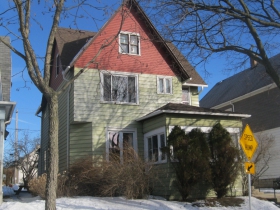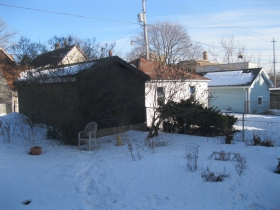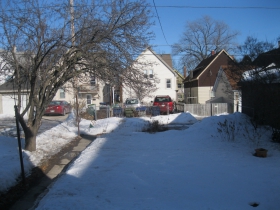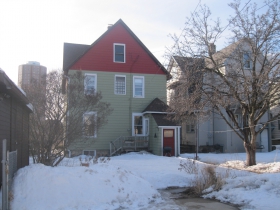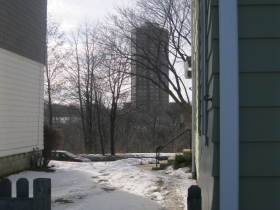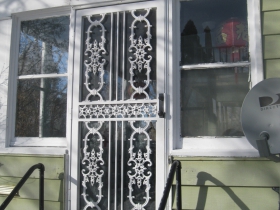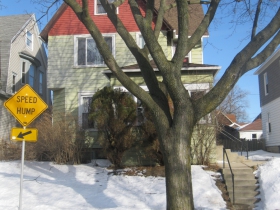Bruce Murphy’s Home for Editors
His home along the Milwaukee River was previously owned by another editor and Carl Sandburg lived just down the street.
In May, 1895 H. Bohlmann took out a permit to build a $2,400 home on Cambridge Ave. in the new Evergreen Park subdivision north of Folsom St., [now E. Locust St.] The two story, 26 ft.by 40 ft. building was designed by Fred Graf, who was later to give us the magnificent Ozaukee County Courthouse and a number of rather grand homes, including one nearby at 2209 E. Kenilworth Place.
This is a more modest affair, located at what was then 728 Cambridge Ave. The home sits on an ample 45 ft. by 120 ft. lot, and pretty much had the entire neighborhood to itself as late as 1910, when dozens of open lots remained around it.
In 1911 owner O. Pfeifer took out a permit to build a $2,000 cottage in the back yard, but no trace remains of this structure, if it was indeed built. What remains today is an attractive and durable 4 bedroom, 1-1/2 bath home of just over 2,000 square feet of living space spread over two levels. There is a full 984 square foot basement down below, and what looks to be a kind of a fun attic above.
By 1925 or so, it was the residence of Dr. C. F. Siefert, further burnishing the middle-class credentials of the home. Then it was valued at $900 for the land and $2,700 for the improvements for a total of $3,600. The Depression did little to hurt the home’s value, which stayed around $3,500 after being boosted up to $4,050 in the giddy years running up to the Depression.
After Doc moved out around 1944 the home for many years was the residence of Rudolph and Esther Spitz. Rudy was an electrician at Harnischfeger; the home remained in his family until May, 1988, when it began its new career as a home for editors. The new buyer was Andrew Muchin, the editor of the Wisconsin Jewish Chronicle, who bought the place in 1988 for $70,000. Muchin, who now lives in Oakland, California, has a public radio show called “Sounds Jewish.”
Muchin sold the home in May, 1993 for $95,000, netting himself about $100 a week for the five years he had occupied the place. It was purchased by Rabbi Isaac D. Serotta who held on to it until May, 1998 when he left to take a position at the Lakeside Congregation for Reform Judaism in Highland Park, Illinois. (Just last month, Serotta visited Rome and had an audience with the pope.)
Murphy and his wife, Rosemarie Balistreri, a retired Milwaukee Public Schools teacher, have made a number of minor changes to the place, which has “good bones,” as they say.
In 1999, the City Assessor poked around the place and noted approvingly the new interior painting. But, “hwd. flrs. could use refinishing. … Overall cond. of dwl is Avg. Roof on rear of dwl shows some wear.”
Since the home’s purchase, its valuation reached a high in 2006, when, at $261,900, it was over twice what Murphy paid. Since then, the valuation has settled down, and the home is now assessed at $45,500 for the land and $172,500 for the improvements for a total of $218,000.
About Cambridge Heights Neighborhood
The Cambridge Heights Neighborhood, a.k.a. “Cambridge Woods,” is nestled along the east bank of the Milwaukee River west of N. Oakland Ave. from E. Locust St. to E. Edgewood Ave., at the border of Shorewood. N. Cambridge Ave., which gives the area its name, is an unusual street in that all homes are on the east side. The west side is unoccupied due to its being a steep hill that descends to the former Chicago & Northwestern Railroad right-of-way, now a popular bicycle trail. To the west of the trail, the site drops even more precipitously to the surging Milwaukee River and the city’s new Greenway. In winter months, when the trees are bare, homeowners get a view of the Milwaukee River, while in season their view is the Cambridge Woods.
Although it lacks homes, the west side of the street has a surprising number of landscape plants, escapees from the gardens across the street. For decades, neighbors would haul their yard trimmings across the street and toss them over the bank. As a result, one can find quite a number of daylillies, hostas and even raspberry bushes growing alongside such nuisances as Boxelders, Buckthorns and garlic mustard plantations. Neighborhood volunteers have made inroads at controlling these invasive species. In season dozens of Buckthorns, properly dug up by the roots, line the bike path awaiting disposal. The riverfront parkland offers a splendid and unexpected escape from the busy city, and it is hard to imagine the bustling intersection of E. Locust St. and N. Oakland Ave. is just steps away. The neighborhood’s most notable dwelling is the “Boat House,” at 3138 N. Cambridge, a most remarkable “Yacht Bungalow” structure built by Edmund B. Gustorf between 1922 and 1924, and a popular drive-by site for architecture buffs.
THE RUNDOWN
- Location: City of Milwaukee
- Neighborhood: Cambridge Heights, a.k.a. Cambridge Woods
- Subdivision: Evergreen Subdivision
- Year Built: 1895
- Style: “Old Style” Residence.
- Size 2,004 square feet
- Taxes: $6,460.21 paid on the installment plan.
- Assessment: Land $45,500 [$8.42 s.f.], Improvements $172,500; Total: $218,500.
- Walk Score: 77 out of 100, “Very Walkable”
- Street Smart: 76 out of 100, “Very Walkable” Axel’s Bar is just around the corner.
- Transit Score: 60 out of 100, “Good Transit.”
How Milwaukee Is It? The residence is about 3 miles from City Hall via the Lakefront.
Photo Gallery
About Bruce Murphy
In May, 2012 Bruce Murphy joined Urban Milwaukee as editor and columnist, and, in a recurrent professional scenario, I followed him there not much longer
Murphy is most celebrated for his stories exposing the 2002 Milwaukee County pension scandal, which led to the resignation of County Executive F. Thomas Ament and the recall of seven county supervisors. Murphy posted these stories on Milwaukeeworld.com (where I followed him as Editor / Publisher), and later did a feature story on the pension for Milwaukee Magazine, which triggered a series of Milwaukee Journal Stories that ran for several months on the newspaper’s front page, triggering widespread outrage among county taxpayers.
House Confidential is happy to visit him on an anniversary related to that story. Twelve years ago today, on February 26th, 2002, Ament resigned as a result of the revelations which Murphy reported.
Murphy had several stints at Milwaukee Magazine, included 12 years as a senior editor and seven as editor, where I worked with him, and three years as a senior enterprise reporter for the Milwaukee Journal Sentinel, where he did numerous front page stories. (I stayed clear of that place).
Murphy was an online innovator, as co-founder and editor/writer of MilwaukeeWorld.com, and has TV credentials as well, having worked as a reporter for the WMVS-TV show “Interchange.” He also forged a path in alternative weeklies, as editor of the upstart Metro Milwaukee Weekly in the late 1990s, where I worked with him until the paper was purchased by the Shepherd Express, where Murphy served as editor in 1999, and I remained as columnist a few more years. He also had a two-year stint with the Madison alt weekly Isthmus in the mid-1980s, where he was an arts and entertainment editor and occasional political columnist.
Murphy has won more than 30 national and state writing awards, including the national Champion Tuck award (1984) for outstanding reporting on economic issues (fellow winners that year were Walter Cronkite, National Public Radio and the New York Times). He’s received nine White Awards from the City and Regional Magazine Association, including back-to-back honors for investigative writing in 1995-1996, and more than a dozen from the state-wide competition of the Milwaukee Press CIub.
Murphy’s signature Murphy’s Law column was created by and featured for nearly two years at MilwaukeeWorld.com, and then continued during his seven years as editor of Milwaukee Magazine and has run at this publication since.
Murphy’s editorial style verges on the monastic. He prefers nice, quiet surroundings with no sudden noises. He has found pleasure in the sport of basketball, but nowadays opts for tennis and roller-blading on the bicycle path. He is very good about going to the theater and other arts events with his wife. As an editor, Murphy is persnickety and as a writer has a remarkable capacity for finding stories in academic studies, data and public records.
–with additional reporting by Jeramey Jannene
House Confidential Database
| Name | City | Assessment | Walk Score | Year |
|---|---|---|---|---|
| Name | City | Assessment | Walk Score | Year |


